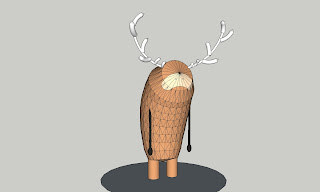I've tried to produce three different walks for the old man. The idea is that, as he gets further from the city and closer to the hills, the old man will become more agile and find a bit of a new lease in life. So the mechanics of the three walks are actually different from each other.
- In the first, excruciatingly slow, walk the man essentially has three legs. He takes a step with the right, a step with the left and then a step with the cane. He needs the cane for support during both of his steps making for slow going! (I think it may actually prove to be too slow when applied in the actual animation).
- In the second he has become able to link together a continuous walk cycle (not the stop start technique he used to use). He only needs his cane to support the step with his left leg (that's the knee that has always given him jip since he came off his trials bike in the woods when he was a teenager... oh no wait that's me!.. maybe it's autobiographical).
- By the third walk he's really feeling good! He doesn't even need the cane anymore but is enjoying swinging it about anyway. He's actually only planting the cane every second cycle of steps now. The fact that we are going to see the old man get to this state, in which he doesn't actually need the cane, hopefully means that we'll find it easier to understand when he eventually forgets it and walks off without it after finding the antler.
I also made this mock up of the scene in which the three walks would be shown, while he is making his way through the arable farmland between the town and the hills. The three 'panels' would play simultaneously although appear one by one from top to bottom. They're also all supposed to have crops in them like the middle panel (although different styles of crops to highlight his progression) and the test is not indicative of the final colour.
It's a pity the quality of video goes down the drain as soon as you upload to blogger. You can't even make out that the action takes place within three seperate framed 'panels' in the second video... you'll just have to imagine it!
I've also tried to make the quality of line seem hand drawn even though it was made digitally and the lines of the character are actually vector based. But there's no hope of scrutinising that in these vids! Oh well.
Another also- spot the wacky first step taken in the first walk! Not intentional.
It's a pity the quality of video goes down the drain as soon as you upload to blogger. You can't even make out that the action takes place within three seperate framed 'panels' in the second video... you'll just have to imagine it!
I've also tried to make the quality of line seem hand drawn even though it was made digitally and the lines of the character are actually vector based. But there's no hope of scrutinising that in these vids! Oh well.
Another also- spot the wacky first step taken in the first walk! Not intentional.















